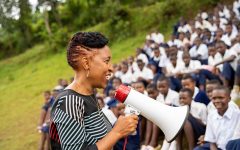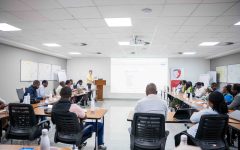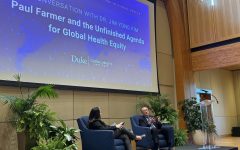Health Ed in a Health Crisis: How UGHE is continuing to provide critical training to students in the midst of a pandemic.
April 30, 2020 2020-04-30 19:51Health Ed in a Health Crisis: How UGHE is continuing to provide critical training to students in the midst of a pandemic.
Health Ed in a Health Crisis: How UGHE is continuing to provide critical training to students in the midst of a pandemic.
It’s a strange time for global education. One of empty classrooms, and quiet school halls. In the face of the pandemic, institutions globally have been grappling with widespread school closures, and teachers everywhere coming to terms with a new era of remote teaching. The University of Global Health Equity (UGHE) is one such institution faced with the transition from a thriving classroom environment, to socially-distanced learning.
Positioned in the heart of the rural north of Rwanda, Burera District, UGHE’s campus offers unparalleled learning opportunities for medical school and masters students in its proximity to local communities and nearby Butaro District Hospital. The journey there from Rwanda’s capital, Kigali, takes just over three hours, winding up to its unique position on a hill close to the border with Uganda. It’s mission? To build the next generation of global health professionals—doctors, nurses, researchers, and public health and policy experts—into leaders and change-makers who strive to deliver more equitable, quality health services for every individual, in every corner of the globe.
And yet, within arguably one of the most remote university settings, UGHE’s teaching within this pandemic continues largely uninterrupted. This is attributed to three reasons; that the remote learning infrastructure – including fiber optic internet and learning management platform – was there long before the pandemic hit (averting the need for any rapid scale-up), faculty are therefore trained and ready to use it, and students continue to commit themselves to learning with the same vigor and dedication as they always have done.
In line with Rwanda’s early and robust response before even its first case on 14 March, prevention has been taken seriously on UGHE’s Butaro Campus – and for good reason. With authorization from the Government of Rwanda, the campus has remained operational, and currently houses nearly 100 staff, students and faculty, all of whom undergo weekly physical and mental health checks by internal professionals. Students now observe six feet distancing on campus at all times, mealtimes are carefully staggered, to help maintain distance whilst eating, and no one enters or leaves the campus save the provision of local food produce and provisions.
Following the pattern globally, isolation has become the new normal and whilst there are many recorded downsides to this such as mental health deterioration and loneliness, within teaching it’s also had its silver linings. “Students that have otherwise been quieter in class, have recently been a lot more engaged,” says Dr. Agazi Gebreselassie, a current student from UGHE’s flagship program, the Masters in Global Health Delivery (MGHD). ‘They are voicing ideas when they wouldn’t otherwise have chipped in before.”
Since lockdown, Dr. Agazi’s classes have continued uninterrupted on the campus learning management system in part due to the fact that this software was up and running long before the W.H.O decreed a pandemic. Now, remote learning is not new for either the students or faculty delivering the sessions. In January this year, MGHD students received an anatomy class from lecturers at Stanford University. Motion and voice sensor cameras, ceiling speakers, projectors, and catchbox microphones were all set up in the campus classrooms to enable the two-way communication, the ‘back and forth’ as Dr. Agazi describes, that is so crucial to learning and student knowledge retention.
If anatomy can be delivered without students needing to be tangibly ‘in the room’, so group work can be managed without, well, groups. “My first reservation when lockdown hit was how we would work in teams,” says Dr. Agazi. His class is currently learning health policy and political economy, one of the core pillars of the MGHD program to which group work is critical. “My team and I are working on a policy brief in isolation; we meet in chat rooms.” It’s crucial group work continues; it prepares students for the realities of working in small or large scale teams in the future, and to become active contributors to health policies and leaders of innovative programs to improve health for the most vulnerable.
Agazi’s description of the current classes as ‘very interactive’ is part due to the capabilities of the learning software, and part to the respective efforts maintained by students and faculty. Dr. Zahirah McNatt, Assistant Professor and Godley-St.Goar Chair of Community Health and Social Medicine, is one such faculty member, adjusting to the new rigors of online-only teaching. “Even though we were used to teaching online, I was a little skeptical before starting this on a more regular, long-term basis.” she says. “My greatest concern was how to maintain the quality of classroom discussions on controversial topics like Female Genital Mutilation (FGM) or tobacco control policy. But by making the most of the software to amplify student voices, we succeeded in facilitating some key conversations in the course.”
In a normal setting, students benefit from small class sizes in flexible spaces that can be configured for unique learning experiences that encourage collaboration. Dr. Zahirah now works on the principle that if students have only a screen to look at, there should be a lot to engage with on it. “I make sure that what’s on-screen is something students can connect with; whether it is the actual course content or just photos of themselves or related topics. I play music and, in this odd virtual world, even play an applause loop at the end of student presentations. I hope it gives them a boost.”
Whilst remote teaching continues in many institutions globally, the question of examinations looms larger. Namely, how do students take exams when in isolation? Clement Muhire, UGHE’s IT Specialist and part-time lecturer, is the brains behind the integration of the monitoring software – ‘Lockdown Browser’ – into UGHE’s system, enabling students to take exams from the comfort of their own rooms, monitored by a camera and locked out of all pages other than that hosting the assignment. “It’s amazing to see it all in action,” says Clement. “Our University has a distinct mission that links everyone; as a team we all understand what it means to invest in higher education in health care, and so we all work together to ensure students always get an optimum quality of learning.”
There are also some challenges. Whilst students at UGHE usually hone their practical education in health care and delivery in real-world scenarios by meeting and treating patients at home and local clinics, this type of learning has now stopped entirely to protect communities and campus residents from transmission of COVID-19. Modules requiring field-based learning have been pushed back to a provisional date later in the year and, according to Dr. Zahirah, “students are practicing their skills, including how to conduct interviews with community members, on campus.”
In wider Rwanda, other education organizations are also rapidly adapting to find new solutions to learning amidst lockdown. Higher ed institutions are using the current state of affairs as an opportunity to nurture new skills outside the curriculum, such as improving student delivery of spoken English languages, as encouraged by the University of Rwanda. The Rwanda Education Board (REB), in partnership with UNICEF, is working to deliver science, mathematics, and other school subjects to primary and secondary school students via radio, addressing the needs of those without access to internet or computers.
In light of the pandemic, continuing learning for UGHE’s students feels more critical than ever. These, after all, are the global health leaders of tomorrow, trained to build and maintain resilient health systems to fight public health challenges like this in the future.‘There is a misconception that education outside cities is somehow lower quality,” says Emmanuel Kamanzi, UGHE’s Director of Infrastructure. “At UGHE, we are striking out this understanding by providing high-quality education to the next generation of health professionals in a rural setting. This mission drives us all.”







